Best hunting hounds, discover why they excel as both sight and scent hunters in our comprehensive guide. From their storied origins to specialized training techniques and breed-specific characteristics, we delve into what makes these dogs indispensable to hunters.
Introduction
Imagine standing in a misty forest at dawn, the only sounds are the distant calls of the wild and the soft rustling of leaves underfoot. In this serene yet exhilarating moment, your hunting hound is by your side, ears perked, nose twitching, ready to spring into action. This is not just a scene from a hunter’s dream but a daily reality for those who partner with these remarkable dogs in pursuit of game.
Hunting with hounds is an ancient practice that marries the thrill of the hunt with the profound legacy of partnership between hunter and hound. These dogs aren’t just pets; they are part of a storied history that stretches back centuries. From medieval hunts to the rugged terrains of the New World, hunt hounds have evolved to become some of the best hunting dogs. They have adapted their incredible sight and scent abilities to meet the needs of hunters across diverse landscapes.
Whether you’re a seasoned hunter or a curious enthusiast, join us on this journey to learn more about the best hunting hounds. Let’s begin.
What Makes Hounds Great Hunting Dogs?

When you step into the field with a hound at your side, you’re not just bringing a dog; you’re engaging a highly specialized ally, honed by centuries of selective breeding and natural instincts. Hunters have long favored these dogs not just for their company but for their unparalleled abilities that make them standout partners in the hunt.
Understanding Hunting Hounds
Hunting hounds are a diverse group, each breed developed with specific traits to suit different hunting styles and environments. From the swift, silent dashes of sighthounds to the relentless tracking of scenthounds, these dogs cover many types of hunting. The best hunting hounds have an instinctual drive to hunt, a trait deeply embedded in their DNA. There’s no question, hunting with hounds is both reliable and effective.
Characteristics of Hunting Hounds
Each breed of hunting hounds boasts unique physical and mental attributes that cater to specific hunting tasks. Sighthounds, such as the Greyhound and Saluki, have lean bodies and long legs, perfect for high-speed pursuits in open fields. Scenthounds like the Bloodhound or Beagle have powerful noses, capable of picking up a trail hours old and across various terrains. Beyond physical traits, hunting hounds are known for their acute awareness and intelligence, which make them adaptable to diverse hunting scenarios.
Unique Abilities of Hunting Hounds in the Field
The real thrill of watching the best hunting hounds at work is seeing their natural talents in action. Imagine a Beagle’s deep, melodious bark echoing through the woods as it tracks, or the electrifying speed of a Greyhound in pursuit of prey. These dogs have an innate ability to switch from calm to high alert, demonstrating both vigor and precision. Their abilities are not just about physical prowess but also about how they use their senses to make split-second decisions that are crucial during a hunt.
The Critical Role of Training Hounds for Different Types of Hunting
Training hounds is an important part of what makes great hunting dogs. It’s less about imposing commands and more about refining their natural instincts to meet specific hunting requirements in the field. This type of training builds on their inherent skills and focuses on enhancing their responsiveness to cues and their ability to work as a partner in the field.
Training sighthounds vary differently from training scenthounds, reflecting their different roles and capabilities in the field. For instance, while a sighthound may be trained to respond to visual commands from a distance, a scenthound may rely more on verbal cues to follow a scent trail.
Training also involves preparing these dogs to handle the different physical and psychological challenges of hunting environments—from coursing to tracking game. The bond that forms through this training is profound, creating a partnership where both hunter and hound understand and anticipate each other’s moves seamlessly.
It’s important to emphasize that the best hunting hounds are better trained by honing their natural skills to suit specific hunting tasks.
The Speed and Sight of Sighthounds
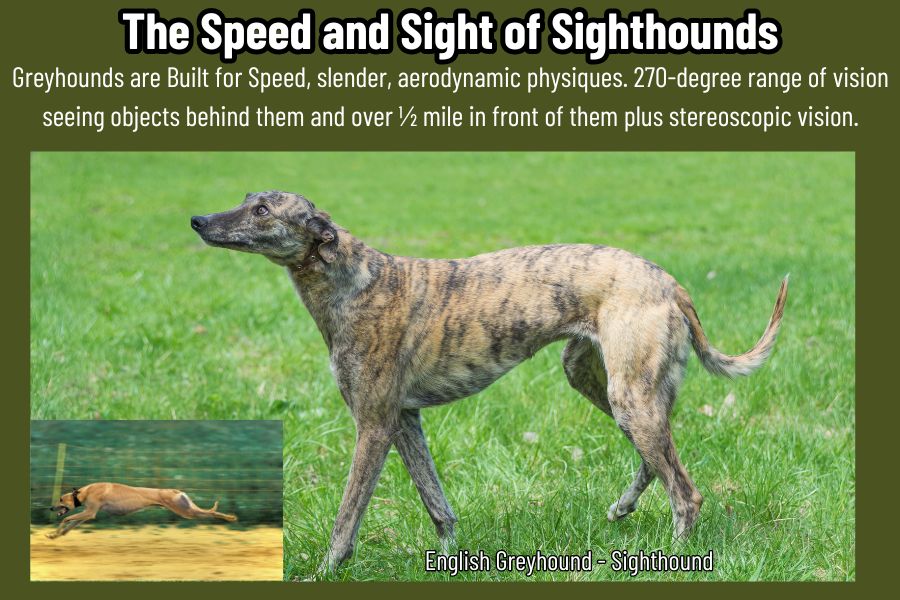
Sighthounds, often celebrated as the athletes of the canine world, are a marvel in the realm of hunting. Renowned for their incredible speed and acute vision, these dogs are the epitome of elegance and efficiency in motion. Their capabilities make them the perfect hound for hunting in open terrains where speed is crucial.
How History and Hunting Needs Have Shaped Sighthounds
The evolution of sighthounds is a tale of natural selection intertwined with human history. Originating from ancient civilizations like Egypt, sighthounds were revered not only for their hunting abilities but also for their grace and beauty. Historical depictions show these dogs hunting alongside pharaohs, chasing down gazelles and hares across the vast desert expanses. This heritage has tailored sighthounds to be visual hunters, relying on their exceptional sight and explosive speed to track and catch fast-moving prey.
A Symphony of Speed and Precision: The Anatomy of a Sighthound
The anatomy of a sighthound is fine-tuned for high-speed pursuits. With their long, slender legs, deep chests for enhanced lung capacity, and lean bodies, these dogs are built to cover large distances very quickly. The key to their hunting prowess lies in their unique visual acuity. Sighthounds are equipped with a wide field of vision, estimated to be up to 270 degrees, allowing them to detect motion from far distances—a critical advantage in open landscapes. This panoramic view, combined with the ability to accelerate rapidly, makes them formidable hunters.
Popular Sighthound Breeds in the Hunt
Among the various breeds, each brings a unique set of skills to the field. The Greyhound, for example, is perhaps the fastest, capable of reaching speeds up to 45 miles per hour, making it a top choice for hunting small, fast-moving game. The Saluki, known for its stamina and agility, excels in endurance hunting, often used in pursuits that require a delicate balance of speed and persistence. Meanwhile, the Irish Wolfhound, one of the tallest breeds, uses its size and power to hunt larger game. A comparative analysis of these breeds reveals a spectrum of capabilities tailored to different hunting needs, from quick, short bursts by the Whippet to prolonged chases typical of the Afghan Hound.
Each sighthound breed brings its own historical and physical allure to the hunt, but all share the common traits of speed, visual acuity, and a deep-rooted history that explains why they are recognized as some of the best hunting hounds.
The Trailblazers: Scenthounds
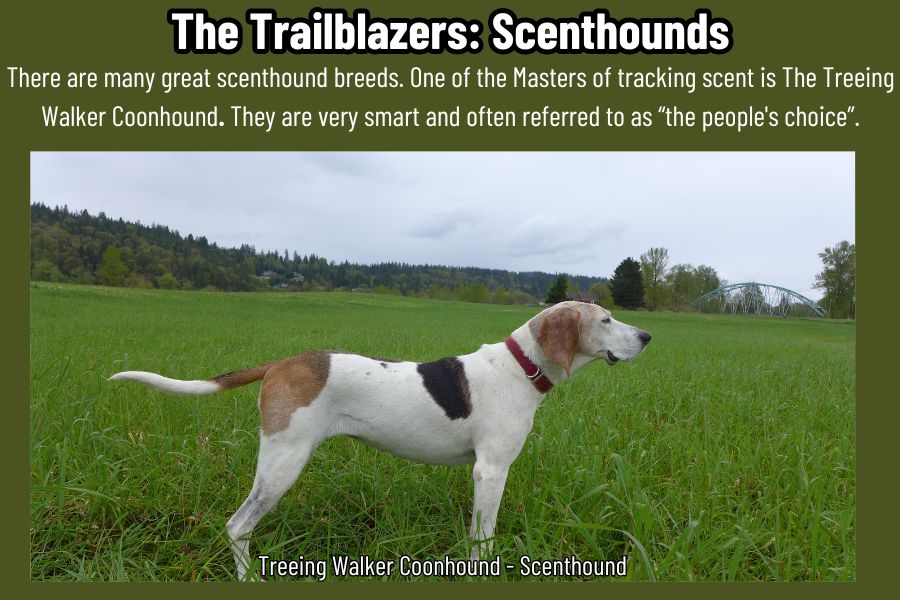
In the world of hunting, Scenthounds are the unmatched specialists of scent, using their noses to lead hunters through dense forests, over rugged terrains, and across open fields. Many of the scenthound breeds are also recognized as some of the best hunting hounds. They are sophisticated scent-detecting machines, tailored by centuries of breeding to become the ultimate trackers.
The Masters of Scent
The success of Scenthounds in the field largely hinges on their extraordinary olfactory skills. A Scenthound’s nose is its most formidable weapon, capable of detecting and distinguishing odors at incredibly diluted concentrations. This ability is rooted in the science of their anatomy: they possess up to 300 million olfactory receptors, compared to a human’s mere five million. Environmental factors such as humidity, wind direction, and temperature play significant roles in their tracking performance, influencing how scent particles are dispersed in the air.
Relentless Drive and Stamina
Scenthounds are built for endurance, not speed. Their bodies are designed to sustain long periods of tracking. Breeds like the Bloodhound or Coonhound have powerful, sturdy legs that allow them to navigate challenging terrains without fatigue. Their relentless drive is a product of both their physical attributes and their breeding purpose—these dogs are literally built to follow trails until the end. This tireless pursuit makes them invaluable as a hound for hunting when the game can cover extensive distances.
Distinguishing Scenthound Breeds
The diversity among Scenthound breeds is vast, each adapted to specific hunting needs and environments. Some examples, the Beagle, small yet mighty, is renowned for rabbit hunting, using its sharp nose to track through thick underbrush. The tenacity of the Basset Hound also excels hunting rabbits and hares. Of course, there’s the storied tradition of the American Foxhound. And we can’t forget the larger Bloodhound, with its solemn face and wrinkled skin, excels in big game tracking such as deer and wild boar. Bloodhounds are also instrumental in man-trailing work due to their detailed scent-following capabilities.
All hunting hound breeds bring a different strength to the hunt by showcasing a range of specializations that cater to various terrains and types of game.
Through their remarkable sense of smell, relentless stamina, and specialized training, Scenthounds demonstrate why they are indispensable in the hunting community.
Comparing Sighthounds and Scenthounds
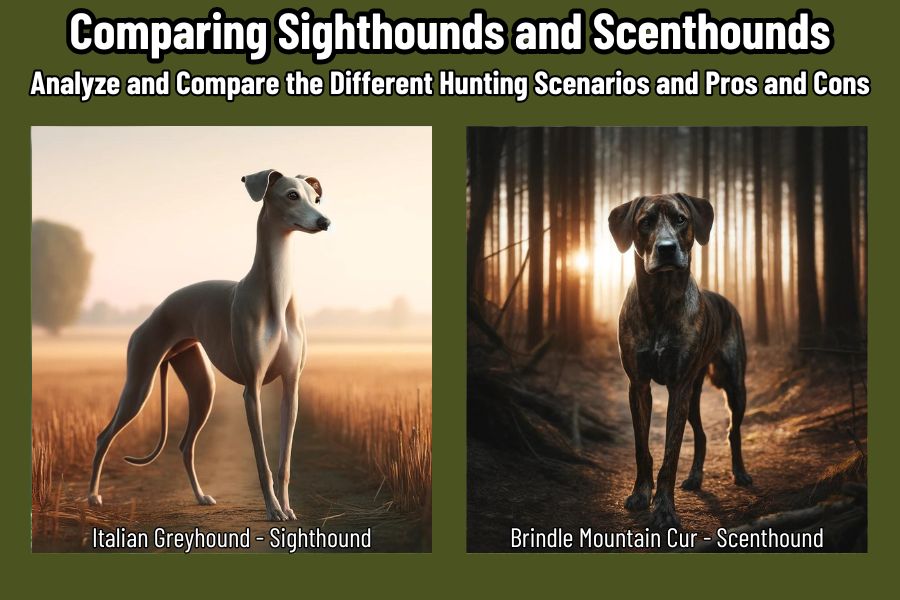
Best hunting hounds, understanding sighthounds and scenthounds and their distinct capabilities is crucial. Each type excels in different scenarios, making them uniquely suited for specific hunting tasks. This comparison will provide some key insights.
Analyzing the Different Hunting Scenarios Suited for Each Type
Sighthounds shine in open areas where their incredible speed and sharp vision can be fully utilized. They are perfect for chasing down fast-moving prey such as rabbits, foxes, and even deer, across plain fields or rolling terrains where long, unobstructed chases are possible. Their ability to quickly spot and sprint after fast-moving objects makes them ideal for hunts that require rapid responses and high-speed pursuits.
Conversely, scenthounds are the experts of dense, challenging environments such as thick forests or brushy areas. Their ability to follow a scent trail for hours or even days makes them indispensable for hunting game like wild boar, bear, and other animals that leave a distinct scent trail. The slower pace of scenthound hunting allows for a more methodical and enduring hunt, suitable for hunters who appreciate the tracking process as much as the catch.
Pros and Cons of Each Hound Type in Various Hunting Conditions
Sighthounds:
- Pros:
- Fast and efficient in catching sighted prey.
- Less reliant on vocal commands, which can benefit stealthy hunting situations.
- Excels in open and semi-open terrains where speed is a significant advantage.
- Equipped with long range vision for spotting prey in front of them plus some have stereoscopic vision.
- Cons:
- Less effective in dense vegetation where visibility is limited.
- Requires careful handling to prevent injury due to their high-speed pursuits.
- Often less interactive with the hunter, focusing more on the chase.
Scenthounds:
- Pros:
- Excellent scent tracking over long distances and through complex terrains.
- Highly persistent, continuing to track despite environmental challenges.
- Their stamina is unmatched, they are built for endurance over long distances
- Strong bond with the hunter, relying on commands and interaction to follow the trail.
- Cons:
- Typically slower, which might not suit hunts requiring quick catches.
- Can become overly focused on a scent trail, making them harder to recall or redirect.
- Often requires more vocal interaction, which could disrupt other wildlife during the hunt.
Whether you value the thrilling speed of sighthounds in the open fields or the steadfast endurance of scenthounds understanding these differences is essential when choosing the right hound for your hunting style.
How to Choose Your Hound Companion?
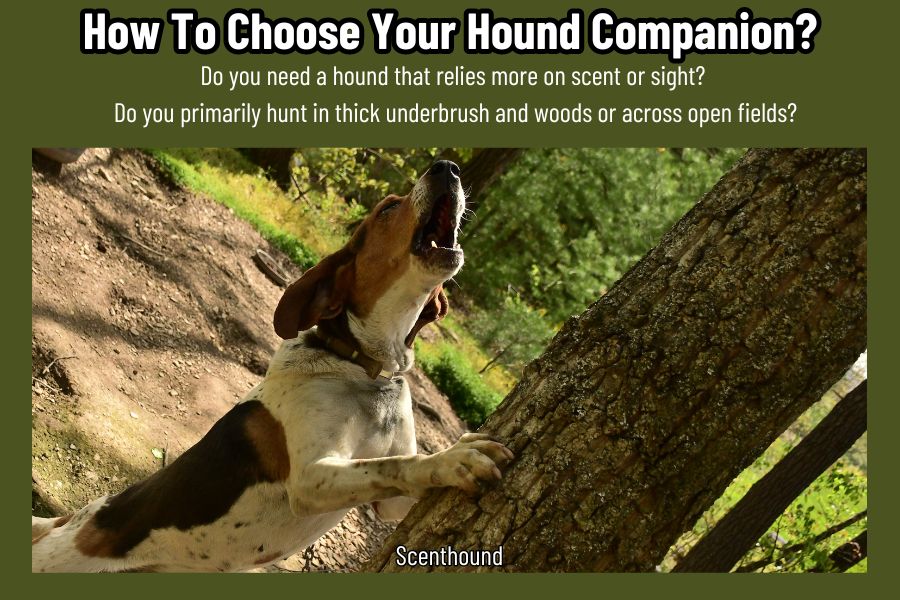
Selecting the right hound for hunting is more than just picking a dog; it’s about finding a partner that complements your hunting style and fits into your lifestyle. Here, we’ll explore how to assess your needs and the key lifestyle considerations to ensure you and your hound are a perfect match.
Assessing the Hunter’s Needs and Matching Them with the Right Hound
Every hunter has unique needs, depending on the type of game, the hunting terrain, and personal preferences. Are you looking for a dog that can maneuver through thick underbrush or one that can chase game across open fields? Do you need a hound that relies on scent more than sight, or vice versa? Answering these questions will help you narrow down the choice between a sighthound and a scenthound.
For instance, if your hunting expeditions often take place in dense forests where tracking game over long periods is essential, a scenthound like a Coonhound or a Bloodhound could be ideal. Conversely, if your hunts are more about speed and less about endurance, choosing a sighthound like the Greyhound might be the way to go. It’s also important to consider the hound’s temperament and energy levels to ensure they mesh well with your hunting approach and personality.
Lifestyle Considerations When Living with a Hunting Hound
Living with a happy hound goes beyond the field; it extends into your daily life. These dogs typically have high energy levels and require considerable exercise, space, and mental stimulation. An apartment might not be the best environment for a large, active hound that thrives on running and exploring. Healthy hounds need regular access to a big yard or frequent trips to open spaces to meet their physical requirements.
Additionally, the breed’s temperament plays a significant role in how well they integrate into your home life. Some hounds, especially certain scenthounds, can be vocal, which might be a consideration if you live in close proximity to others. Furthermore, your ability to provide consistent training and companionship will directly affect your hound’s happiness and behavior at home. The best hunting hounds are ultimately the ones that match your needs and lifestyle with their capabilities.
The Bond Between Hunter and Hound
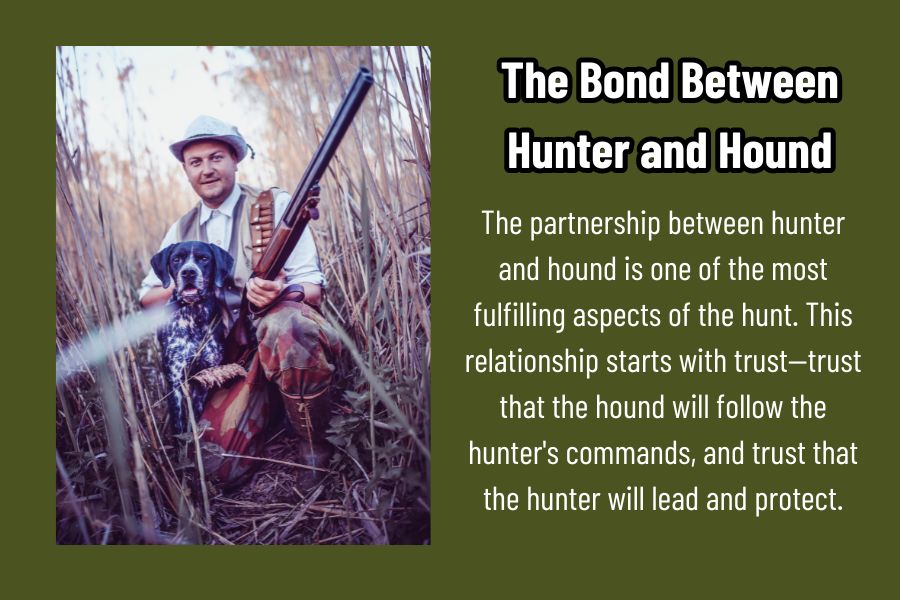
The hunter and hound relationship is the foundation of a successful hunting partnership. Here, we’ll explore the dynamics of this special relationship and share some captivating stories that highlight the impact hounds have on their hunting partners.
The Special Relationship Between Hunter and Hound
At the heart of hunting with hounds lies a partnership that is built over countless shared experiences in diverse environments. This relationship starts with trust—trust that the hound will follow the hunter’s commands, and trust that the hunter will lead and protect. Over time, this evolves into an intuitive understanding, where each can anticipate the other’s actions and reactions. This synergy enhances not only the practical aspects of hunting but also creates a shared rhythm that is a source of joy and satisfaction during each hunt.
Training sessions play a crucial role in forming and strengthening this bond. As the hunter teaches the hound, both learn to communicate effectively, sometimes without words, through gestures, looks, and an acute awareness of each other’s body language. The bond that forms through these interactions is one of the most rewarding aspects of hunting with hounds, providing a unique companionship where both hunter and hound are attuned to each other’s needs and moods.
Interesting Stories About Bonding with Hounds and Their Impact
There are numerous tales in the hunting world that illustrate the remarkable impact hounds have on their owners. One such story is of a Bloodhound named Duke, who was instrumental in tracking down a lost child in the dense forests of Virginia. Duke’s ability to follow the child’s scent over several miles and through challenging terrain resulted in a safe and heartwarming reunion with the child’s family. This event not only showcased Duke’s incredible tracking skills but also highlighted the trust between him and his handler, which was critical to the mission’s success.
Another story comes from the moors of Scotland, where a hunter and his Greyhound faced the challenge of a lifetime during a particularly harsh winter. During a hunt, they became separated by a sudden snowstorm. The Greyhound, using its keen sense of direction and loyalty, found its way back to the hunter’s cottage and led a rescue party back to the hunter, who was found hypothermic but alive. This story speaks volumes about the loyalty and determination of hounds, qualities that endear them to hunters beyond their skills in the field.
These stories, among many others, are testaments to the deep and impactful connections that form between the best hunting hounds and their owners. They not only illustrate the skills and abilities of the hounds but also underscore the profound emotional bonds that make the partnership between hunter and hound one of the most fulfilling aspects of the hunting tradition.
Wrapping Up: Why Hounds are an Indispensable Member of the Hunt?
As we have explored throughout this discussion, the best hunting hounds are not merely participants in hunting; they are central to the tradition, enhancing every aspect of the hunt with their skills, companionship, and loyalty. From the unparalleled speed and agility of sighthounds in open fields to the relentless tracking abilities of scenthounds through dense woods, these dogs bring a diversity of talents that are tailored to various hunting needs.
Their roles go beyond mere functionality; they add a layer of connection and partnership that enriches the hunting experience. Whether through the deep, instinctual bond that forms when hunting with hounds or the sheer joy of watching a well-trained hound in action, these animals are more than just tools of the hunt—they are partners in every sense.
In conclusion, the integration of hounds into hunting is a tradition as old as any, woven deeply into the fabric of the hunting culture. Great hounds are indispensable, irreplaceable, and undeniably central to the spirit of the hunt.
FAQs: Best Hunting Hounds
What makes a dog a sighthound?
Best Hunting Hounds Answer:
Sighthounds are distinguished by their unique reliance on vision to hunt, rather than scent. This group of agile and fast dogs excels in spotting and chasing down prey at high speeds across open terrains. Commonly recognized breeds include the Greyhound, Whippet, and Italian Greyhound, celebrated for their sleek forms and swift movements. Lesser-known yet equally fascinating are the Saluki, Galgo, Borzoi, and Irish Wolfhound, each with distinct characteristics and hunting capabilities that showcase their visual acuity and speed.
What is the king of sighthounds?
Best Hunting Hounds Answer:
The Afghan Hound holds the esteemed title of the “King of Sighthounds.” This designation stems from its majestic appearance and storied past, making it one of the oldest and most regal dog breeds known. With its striking silhouette, long flowing coat, and dignified demeanor, the Afghan Hound embodies the essence of nobility and grace in the canine world.
How smart are sighthounds?
Best Hunting Hounds Answer:
Sighthounds are known for their intelligent and independent nature. While their primary trait is their physical speed and ability to chase visually, they also possess a quiet intelligence that makes them surprisingly easy to train in the right hands. Contrary to their high-energy hunting persona, they are often gentle and reserved at home, demonstrating a depth of character that belies their athletic prowess.
What is the difference between a Sighthound and a Scenthound?
Best Hunting Hounds Answer:
The fundamental difference between sighthounds and scenthounds lies in their primary hunting senses. Sighthounds use their acute vision to spot and pursue prey across long distances, typically in open fields where speed is crucial. In contrast, scenthounds use their highly developed sense of smell to track game, following scent trails over and through varied terrains, often relying on endurance rather than speed.
What makes a scenthound unique?
Best Hunting Hounds Answer:
Scenthounds are celebrated for their extraordinary olfactory abilities, among the best in the canine world. They are specially adapted to follow complex scent trails over long distances and through challenging environments. Characteristics such as long, drooping ears and significant nasal cavities enhance their ability to pick up and retain scents. These physical features, combined with their robust legs and tenacious spirit, make scenthounds unparalleled trackers.
What is the history of the Scenthound?
Best Hunting Hounds Answer:
The history of scenthounds is deeply intertwined with selective breeding practices that date back to the Middle Ages. Originating from St. Hubert’s Monastery in Belgium, these dogs were developed using Celtic dogs from Gaul (modern-day France). The monks bred for specific traits, resulting in the medium-sized, black and tan dogs known today for their heavy heads and sturdy frames. This breeding aimed to refine the dogs’ scent tracking abilities, leading to the proficient scenthounds we recognize today.
FAQs: Resources
Best hunting hounds, the following resources provide both practical knowledge and a deeper look into the historical and cultural significance of hunting hounds.
SPECIAL NOTE: “The information provided in this post about best hunting hounds is based on research using the Resource links listed below. While we try to keep the information for this post current, there are no representations expressed or implied, about the completeness, or accuracy of the information provided. Therefore all hunters should always verify current information from these resources along with other local and federal publications”.
Blog Post
- Best Hunting Dogs – Gun Dogs and Hunting Hounds
Other Online Resources
- American Kennel Club (AKC) – Search Breeds
- The Kennel Club (TKC) – Search Breeds A-Z
- United Kennel Club (UKC) – Hunting OPS
- Canadian Kennel Club (CKC) – Hounds
Books
Here are some recommended books about the best hunting hounds and their training.
- “Hounds: Hunting by Scent” by Marcella Kelly and Ed Bailey
This book offers a detailed look into the world of scent hounds used in hunting. It provides insights into the training, handling, and effectiveness of various scent hound breeds in hunting scenarios. - “The World of Sighthounds” by Patrick Burns
This book provides an in-depth exploration of sighthounds around the globe, focusing on their roles in hunting and the specific attributes that make each breed unique in the hunting field. - “A Breed Apart: The Hounds and the Dogs of Field and Forest” by Alexander Mackay-Smith
This book traces the history and development of hunting hound breeds, packed with stories that highlight the roles these dogs have played in hunting traditions throughout history. - “The Hound and the Hawk: The Art of Medieval Hunting” by John Cummins
While not exclusively about hounds, this book delves into the rich history of medieval hunting, where hounds played a pivotal role. It provides a fascinating look at the cultural and social significance of hunting with hounds during the medieval period.


